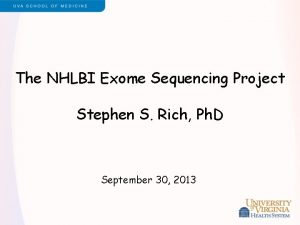Application of Whole Exome Datasets to Test the

- Slides: 1

Application of Whole Exome Datasets to Test the Hypothesis of Digenic Inheritance in Stargardt Disease K Lee 1, D Marchuk 1, MJ Friez 2, C Bizon 3, P Owen 3, KE Weck 1, 4, S Garg 5, JP Evans 1 and JS Berg 1 1 Department of Genetics, University of North Carolina at Chapel Hill, North Carolina 2 Greenwood Genetic Center, Greenwood, South Carolina 3 Renaissance Computing Institute, Chapel Hill, North Carolina 4 Department of Pathology and Laboratory Medicine, University of North Carolina at Chapel Hill, North Carolina 5 Department of Ophthalmology, University of North Carolina at Chapel Hill, North Carolina RESULTS: Forty-seven (3%) individuals from the three datasets were identified as ABCA 4 carriers. We analyzed 93 ABCA 4 variants and 470 variants within 213 additional genes associated with retinal disorders in the 47 ABCA 4 carriers. BACKGROUND: Whole exome sequencing (WES) is a valuable tool in determining the molecular etiology for retinal disorders given their genetic heterogeneity. We performed WES in 53 patients with various retinal disorders. Two patients with simplex Stargardt disease (SD; OMIM 248200) harbored one pathogenic variant in ABCA 4 and one pathogenic variant in a second retinal disease gene (CNGB 3 or GUCA 1 A) suggesting the possibility of digenic inheritance. Digenic inheritance has been previously reported in retinitis pigmentosa and in one family with macular dystrophy. Digenic inheritance has not been previously reported in patients with SD. However, approximately one-third of simplex cases have only one identifiable mutation in ABCA 4. Digenic inheritance may offer an explanation for a subset of these patients. PARTICIPANTS: Six participants with SD have been enrolled in the NCGENES Study, which is designed to assess the effectiveness of WES FOR DIAGNOSING patients with a variety of suspected genetic disorders. One participant was found to have two pathogenic ABCA 4 variants consistent with recessive autosomal SD. A second was found to harbor a pathogenic variant in the PRPH 2 gene associated with autosomal dominant SD, which was consistent with the family history. WES in four participants with no family history of SD had only one ABCA 4 pathogenic variant identified. Two of these four participants harbored a second pathogenic variant in gene associated with SD. Proband A ABCA 4 c. 2827 C>T (p. R 943 W) Proband B ABCA 4 c. 4918 C>T (p. R 1640 W) CNGB 3 c. 1148 del. C (p. T 383 fs) GUCA 1 A c. 149 C>T (p. P 50 L) Pathogenic variants in ABCA 4 and CNGB 3 are associated recessive SD. GUCA 1 A is associated with dominant SD; however, variants within this gene have been associated with incomplete penetrance. Thus, the ABCA 4 variant may act as a modifier in this individual. STUDY DESIGN: We evaluated the frequency of individuals representative of the general population who were carriers of an ABCA 4 pathogenic variant and a pathogenic variant in another gene associated with retinal disease. Three separate WES datasets not enriched for retinal disorders were utilized to detect carriers, which included a combined 1, 478 individuals from the NCGENES Study, Greenwood Genetic Center and 1000 genomes. Individuals with ABCA 4 variants previously reported as pathogenic, or rare (<1% minor allele frequency) and possibly damaging (missense, nonsense, frameshifting indels, canonical splice site), were selected for further analysis. These individuals were further screened for pathogenic variants in 213 additional retinal disease genes. Pathogenicity was assessed by allele frequency, conservation data, in silico modeling and co-segregation data. FIGURE 1 – Pedigree of Proband A illustrating a pattern of inheritance consistent with recessive inheritance. Sanger sequencing conducted in the father of Proband A revealed the CNGB 3 variant but did not identify the ABCA 4 variant. FIGURE 2 – Pedigree of Proband B illustrating a pattern inconsistent with dominant inheritance. Family members were not available for co-segregation studies. A B A Figure 3 – A) Fundus photo of Proband B. B) Autofluorescence imaging of Proband B displaying bull’s eye maculopathy characteristic of Stargardt disease. Table - ABCA 4 Carriers in WES Datasets with Pathogenic Variants in Other Retinal Disease Genes Individual Potential Retinal Disease Variant Associated Disorder(s) 1 c. 5908 C>T BBS 10 c. 271 ins. T (p. Cys 91 fs) (p. Leu 1970 Phe) 2 c. 5908 C>T Usher syndrome; USH 2 A c. 14489 C>G (p. Ser 4830*) (p. Leu 1970 Phe) Retinitis pigmentosa 3 c. 3113 C>T ABCC 6 c. 3421 C>T (p. Arg 1141*) (p. Ala 1038 Val) Pseudoxanthoma elasticum 4 c. 1927 G>A (p. Val 643 Met) Alstrom syndrome 5 c. 1927 G>A EYS c. 5928 -2 A>G (p. Val 643 Met) Retinitis pigmentosa 6 c. 6320 G>A PDE 6 A c. 908 C>G (p. Ser 303 Cys) (p. Arg 2107 His) Retinitis pigmentosa 7 c. 6079 C>T GUCY 2 D c. 2302 C>T (p. Leu 2027 Phe) (p. Arg 768 Trp) Leber Congenital Amaurosis c. 5908 C>T BBS 9 c. 190 C>T (p. Gln 64*) (p. Leu 1970 Phe) Bardet-Biedl syndrome 8 Eight variants of possible pathogenicity was identified in eight ABCA 4 carriers within the PDE 6 A, EYS, ALMS 1, USH 2 A, BBS 9, BBS 10, ABCC 6 or GUCY 2 D genes. However, no ABCA 4 carrier had a known pathogenic variant in other genes associated with Stargardt disease , including PROM 1, PRPH 2, ELOVL 4 and CNGB 3, or GUCA 1 A. Although more cases are needed to strengthen the digenic inheritance hypothesis for Stargardt disease, the lack of double heterozygotes among controls is a statistically significant difference (Twotailed Fisher's exact test P<0. 005). Figure 4 – A) Multifocal electroretinogram of Proband B illustrating the significant loss of cone photoreceptor cells characteristic of Stargardt disease. ABCA 4 Variant One individual with no known history of a retinal disorder had two previously reported pathogenic ABCA 4 variants (p. Leu 1970 Phe & p. Gly 863 Ala); however, the Gly 863 Ala variant appears to be a hypomorphic allele only disease causing when in trans with a truncating mutation. This likely explains the lack of phenotype. There is also a possibility that the variants are in cis. No additional pathogenic variants in other retinal genes were identified in this individual. ALMS 1 c. 9370 C>T (p. Gln 3124*) Bardet-Biedl syndrome Eight of 47 (17%) ABCA 4 carriers had a previously reported or likely pathogenic variant within another retinal disease causing gene. None of these variants were confirmed with Sanger sequencing. Therefore, the possibility remains that one or more of these variants could be WES artifacts. All variants identified were associated with autosomal recessive conditions and most genes are associated with syndromic retinal dystrophies. SUMMARY AND FUTURE DIRECTIONS: Our preliminary analysis suggests that double carrier status for ABCA 4 and a second Stargardt disease gene is rare in the general population, supporting the possibility that double heterozygous mutations in two Stargardt disease associated genes could be causative for this condition. Additionally, WES datasets are an effective method to evaluate heterogeneous disorders for the presence of double carrier status as a means to test the hypothesis of digenic inheritance. We plan to enrich enrollment of Stargardt disease patients with only one identifiable pathogenic ABCA 4 mutation into the NCGENES Study to investigate the frequency of double carrier status in a larger cohort, which could potentially bolster evidence of digenic inheritance. Analysis of larger WES data sets is also necessary to statistically power this hypothesis. ACKNOWLEDGEMENTS: We are indebted to our patients for their participation. We would also like to thank NCGENES Study Coordinator, Myra Roche, MS, CGC, for coordinating family studies. This study was supported by NIH 1 U 01 HG 006487, NCTra. CS 550 KR 21216, Research to Prevent Blindness, Bryson Program for Human Genetics and University Cancer Research Fund.

